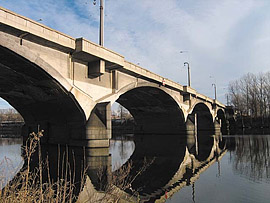
Mosts are protected as cultural heritage, but many are also falling into disrepair
 |
According to historian and publisher František Honzák, who prepared an online database of bridges in the Czech Republic, there are currently about 10,000 bridges in the country that are in poor to critical condition. The protected ones are primarily historical bridges. In the case of newer bridges, disputes sometimes arise between owners and experts - according to the owners, heritage protection is an obstacle to repairing the bridge.
Prague 8 thus wants to significantly rebuild the longest Prague bridge, the Libeň Bridge, which politicians claim is insufficient in capacity and damaged. A replica of the bridge is being prepared, but much larger. However, experts argue that the work of architect Pavel Janák will thus lose its value; studies are also available indicating that a larger capacity of the bridge is not needed.
In Prague, 16 out of several hundred bridges are protected, including the first reinforced concrete bridge in Prague - the Hlávkův Bridge, which was also designed in 1909 by statician František Mencl alongside Janák, who significantly influenced the appearance of modern bridges in Prague. Both also designed the Libeň Bridge in 1924 and 1925. The Jiráskův Bridge from 1926 to 1932, which is the work of František Mencl and architect Vlastislav Hofman, is also protected. The Ministry of Culture has twice refused to declare the Libeň Bridge a monument.
Prague 8 continues to advocate for the billion investment. "Monuments of Czech 20th-century architecture are entering troubled times. Their value is now decided by a few officials at the Ministry of Culture, and not even entire assemblies of experts can reverse their verdict," says historian of modern architecture Rostislav Švácha. According to him, there does not have to be a contradiction between the monument status of a building and the intention to repair it. Declaring it a monument only provides a guarantee that the repair will be carried out in a cultural manner and that the architectural value of the building will be preserved, he stated.
Bridges as connectors between various inhabited places have a multi-thousand-year tradition. Among the oldest evidence of bridges in the country are fragments found underground at Prague’s Vyšehrad, underground at the Můstku metro station, and remnants of Judith’s Bridge near the Charles Bridge. There are hundreds of stone arch bridges from the Middle Ages to Baroque and later, and most of them are protected.
Since the 19th century, wood and stone have been giving way to steel and concrete. According to Švácha, 20th-century bridges can be distinguished between those that are technically interesting and those that attract due to the name of a famous architect. "Rarely do both things coincide," notes the historian.
Bridge engineers had already established their own aesthetic criteria during the 19th century. Beautiful bridges, according to them, are those that achieve an extraordinary span between pillars while using the materials in a very economical manner. Architects, on the other hand, tended to imprint bridges with a distinctive artistic form, which matters less to the bridge engineers.
The Žďákovský Bridge, which had the largest arch span in the world at its time, is steel and, according to historians, is the most significant structure of its kind in the post-war period. As an advocate for quality architecture from the 70s and 80s, Švácha also mentions the Barrandovský Bridge by statician Jiří Hejnice and architect Karel Filsak, which is a unique example of the brutalist style applied to bridge design.
After 1989, bridges in Ústí nad Labem and České Budějovice by Roman Koucký stood out; the bridge in Ústí even received an award from the International Association of Steel Structures, though according to staticians, it uses strange hybrid constructions and too much material.
According to Lukáš Beran from the Research Center for Industrial Heritage, the Prague Nuselský Bridge is currently underappreciated from an architectural perspective, although it is not yet protected as a monument.
The English translation is powered by AI tool. Switch to Czech to view the original text source.
0 comments
add comment











